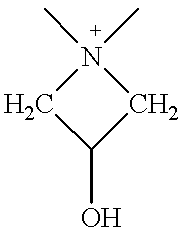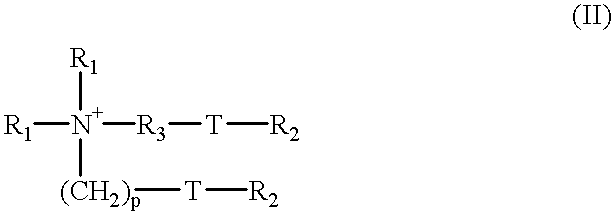Fabric care composition
a technology of fabric care and composition, applied in the direction of detergent composition, detergent compounding agent, soap detergent with other compounding agents, etc., can solve the problems of fabric surface appearance, fabric can be damaged in several ways, and the fabric is too harsh to be treated in the laundry process, so as to reduce the creasing of fabric, facilitate contact, and increase the dimensional stability of fabri
- Summary
- Abstract
- Description
- Claims
- Application Information
AI Technical Summary
Benefits of technology
Problems solved by technology
Method used
Image
Examples
examples 1-3
Experimental Procedure
The amine epichlorohydrin resin used in the following tests is Apomul SAK, (ex. Brookstone Chemicals) which has an azetidinum functional group. It was prepared as an aqueous solution and utilised as a percentage of the weight of fabric treated (% on weight of fabric (owf)) to show its effect on fabric dimensional stability.
Two types of fabric, cotton interlock and cotton poplin, were used in the procedure below. Each fabric was tested in the weft and warp direction, figures relating to the % dimensional change (by multiplying the % change in the weft direction by the % change in the warp direction) have been tabulated.
All fabrics pieces were pre-washed prior to treating (40.degree. C. cotton wash in a Miele Novotronic W820 Front Loading Washing Machine, Wirral water, 100 g Persil non biological washing powder, then tumble dried in a Miele Novotronic T430 Tumble Dryer). The fabrics pieces were then marked up using the M&S Shrinkage Rule and labelled. Four pieces...
example 4
Each load consisted of ten 45 cm.times.45 cm pieces of cotton sheeting, six 45 cm.times.45 cm pieces of 50:50 polycotton, five 45 cm.times.45 cm interlock and the load made up to 1 kg using cotton sheeting ballast. The experiments were done in duplicate with each load being combined for tumble drying. Each load was washed in a Miele.RTM. machine using a 40.degree. C. economy wash and either no additive to the rinse (untreated), CT 45E silicone polymer from Wacker (0.5% owf) or a composition according to the invention containing a PAE (0.32% owf) (Apomul SAK.TM.) and CT45E (0.18% owf). After tumble drying in a Miele.RTM. machine on normal setting until the anti-crease finish had been obtained, the cotton sheeting samples were panelled against standards (the best two and worst two samples were removed prior to panelling).
The results of the panel testing on a scale of 0 for no creasing to 100 for maximum creasing are as follows:
example 5
The previous example was repeated using loads consisting of ten 40 cm.times.40 cm pieces of cotton sheeting, six 40 cm.times.40 cm pieces of 50:50 polycotton, five 40 cm.times.40 cm pieces of interlock and the load made up to 1 kg using cotton sheeting ballast. The additives added to the rinse were none (untreated), Comfort.RTM. fabric conditioner (0.25% owf) or the composition according to the invention as used in the previous example. The loads were varied in each machine ensuring that after 5 loads each treatment had been in the same number of machines. After each wash the loads were combined and dried in a Miele.RTM. tumble dryer on normal setting until the anti-crease finish had been obtained. The cotton sheeting samples were panel tested after the fifth wash.
The results are as follows:
PUM
| Property | Measurement | Unit |
|---|---|---|
| weight average mean molecular weight | aaaaa | aaaaa |
| temperature | aaaaa | aaaaa |
| temperature | aaaaa | aaaaa |
Abstract
Description
Claims
Application Information
 Login to View More
Login to View More - R&D
- Intellectual Property
- Life Sciences
- Materials
- Tech Scout
- Unparalleled Data Quality
- Higher Quality Content
- 60% Fewer Hallucinations
Browse by: Latest US Patents, China's latest patents, Technical Efficacy Thesaurus, Application Domain, Technology Topic, Popular Technical Reports.
© 2025 PatSnap. All rights reserved.Legal|Privacy policy|Modern Slavery Act Transparency Statement|Sitemap|About US| Contact US: help@patsnap.com



